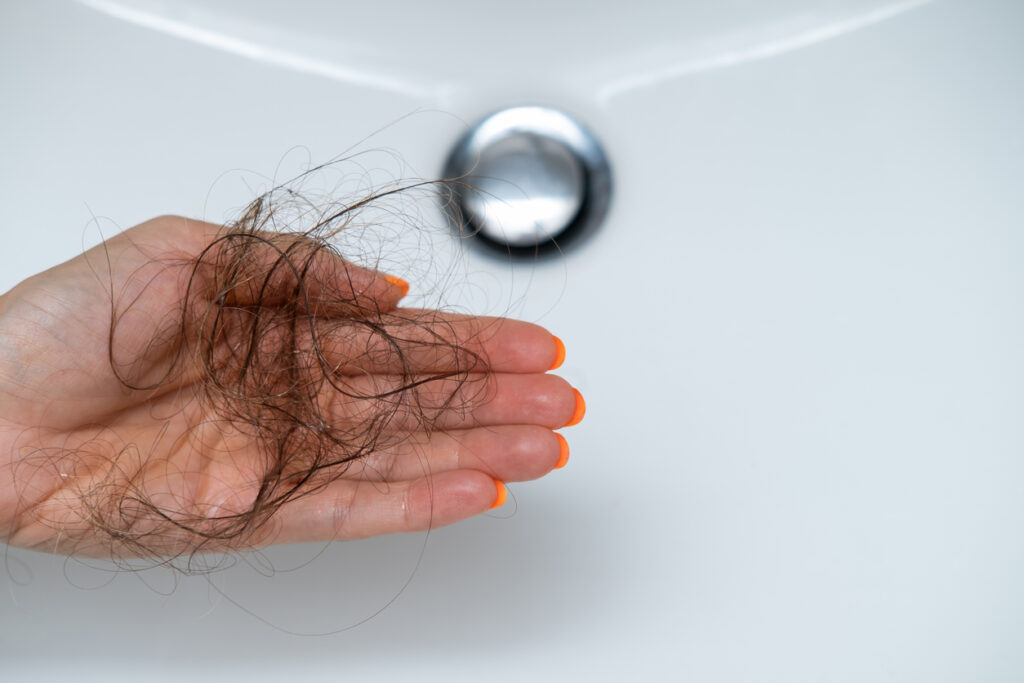When evaluating a patient with hair loss, consider allergic contact dermatitis (ACD) as a potential cause, urges Carolyn Goh, MD, a Clinical Professor of Dermatology at UCLA Health in Los Angeles, CA.
“It has an atypical presentation [in the form of] hair thinning, eczematous lesions, and pruritus, so it may also be more prevalent than we realize,” she says. Dr. Goh discussed hair loss management for ACD and massive weight loss following use of injectable medications at the California Society of Dermatology and Dermatologic Surgery (CalDerm) and the Pacific Dermatologic Association (PDA) in San Diego, CA.
What is Scalp ACD?
Scalp ACD typically occurs with concomitant dermatitis in “rinse-off” areas, such as the neck and face, she adds. The most common allergens are para-phenylenediamine (PPD), nickel, and fragrance mix. “Allergic contact dermatitis has also been implicated in some types of scarring alopecias, especially frontal fibrosing alopecia (FFA) and lichen planopilaris.” Consider patch testing in recalcitrant patients, she advises, as well as in those who wash their hair or scalp daily but report increased itching afterward.
According to pooled results from multiple studies, the five most common allergens in FFA are balsam of Peru, benzophenone, fragrances, gallates, and hydroperoxides of linalool.
Low-dose oral minoxidil (LDOM) has emerged as a viable treatment for many adolescents and adults experiencing hair loss among the available therapeutic options.
According to an international modified Delphi consensus statement from 43 hair loss experts, 76 items achieved consensus, including diagnoses for which LDOM may provide direct or supportive benefit, such as androgenetic alopecia, age-related pattern thinning, alopecia areata, telogen effluvium, and traction alopecia.¹ In Dr. Goh’s clinical experience, patients with scarring alopecia who often experience scalp health issues and significant itching are strong candidates for LDOM as a first-line option, given their difficulty tolerating additional topical treatments.
The consensus statement lists several contraindications to the use of LDOM, including ongoing usage of other drugs with significant oral minoxidil interaction, history of pericardial effusion/tamponade, history of pericarditis, congestive heart failure, and history of pulmonary hypertension associated with mitral stenosis. “Hypotension was not considered a strict contraindication, but maybe exercise a little more caution there, as well as for those with a history of tachycardia or renal impairment,” Dr. Goh says.
The recommended starting dose of LDOM for adult females is 1.25mg daily, with a dosing range of 0.625 to 5mg daily, according to the consensus statement. For adult males, the starting dose is 2.5mg daily, with a dosing range of 1.25 to 5mg. For adolescent females, the recommended starting dose is 0.625 mg daily, with a range of 0.625 to 2.5mg. For adolescent males, the starting dose is 1.25mg daily, with a range of 1.25 to 5mg. “The number of clinicians who prescribe oral minoxidil is actually quite small, so I think it’s still something that more people could be doing,” Dr. Goh says.
Injectable Weight Loss Medications and Hair Loss: Is there a connection?
As more patients use glucagon-like peptide-1 (GLP-1) receptor agonists for weight loss and to manage their type 2 diabetes, reports of these drugs’ effects on hair loss have emerged, including a retrospective cohort study2 and a disproportionality analysis3 of the U.S. Food and Drug Administration (FDA) adverse event reporting system (FAERS) from 2022 to 2023. According to Dr. Goh, these and other studies show an increase in hair loss with semaglutide (Ozempic and Wegovy, Novo Nordisk) and tirzepatide (Mounjaro and Zepbound, Eli Lilly), “and hair loss may be one of the more common adverse effects reported overall,” she says. “Two case reports (one in androgenetic alopecia4 and one in folliculitis decalvans5) have shown improvement.
The story is still out there. Telogen effluvium does occur, and there are also associations with increased testosterone levels in the blood. But maybe this is improving insulin sensitivity, improving the blood flow to the hair, reducing fibrosis and reducing inflammation, and ultimately, because of helping the insulin sensitivity, reducing the hyperandrogenic states.”
She also notes that different GLP-1 receptor agonists may have varying effects on hair loss, and that dosing differs between treatment for type 2 diabetes and weight loss.
April W. Armstrong, MD, Professor and Chief of Dermatology at UCLA, who moderated the session during Goh’s presentation, adds that the consensus statement on recommended dosing of LDOM “will be very helpful for patients and clinicians as we embrace this therapy, especially for those with androgenetic alopecia.” She adds that the GLP-1a picture “has yet to be elucidated. The use of these medicines will reduce insulin resistance, which can have beneficial effect on hair growth. However, we also know that sometimes, with rapid weight loss, patients can experience hair loss. More study is needed.”
–Doug Brunk
References:
- Akiska YM, Mirmirani P, Roseborough I, et al. Low-Dose Oral Minoxidil Initiation for Patients With Hair Loss: An International Modified Delphi Consensus Statement. JAMA Dermatol. 2025;161(1):87-95. https://pubmed.ncbi.nlm.nih.gov/39565602/
- Burke O, Sa B, Cespedes DA, Sechi A, Tosti A. Glucagon-like peptide-1 receptor agonist medications and hair loss: A retrospective cohort study. J Am Acad Dermatol. 2025;92(5):1141-1143. https://pubmed.ncbi.nlm.nih.gov/39863171/
- Buontempo MG, Santos BT. Exploring the hair loss risk in glucagon-like peptide-1 agonists: Emerging concerns and clinical implications. J Eur Acad Dermatol Venereol. 2025;39(2):263-264.https://pubmed.ncbi.nlm.nih.gov/39854119/.
- Gordon ER, Musleh S, Bordone LA. Treatment of insulin resistance with tirzepatide leading to improvement of hair loss. JAAD Case Rep. 2024 Jun 11;50:123-125. https://pubmed.ncbi.nlm.nih.gov/39135763/
- 5. Improvement of Recalcitrant Folliculitis Decalvans With Tirzepatide: A Case Report. Improvement of Recalcitrant Folliculitis Decalvans With Tirzepatide: A Case Report. Cureus 16(12): e76267.https://www.cureus.com/articles/325695-improvement-of-recalcitrant-folliculitis-decalvans-with-tirzepatide-a-case-report#!/


